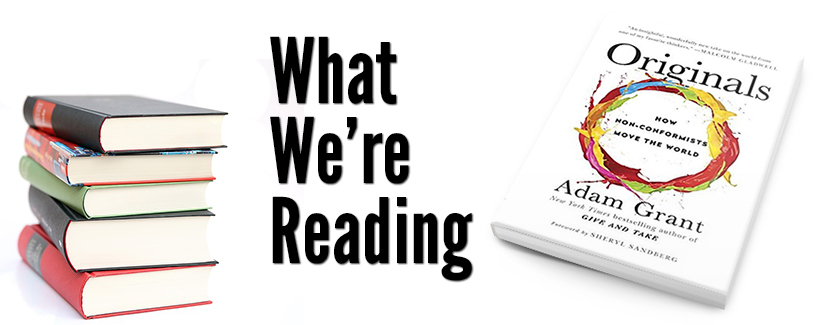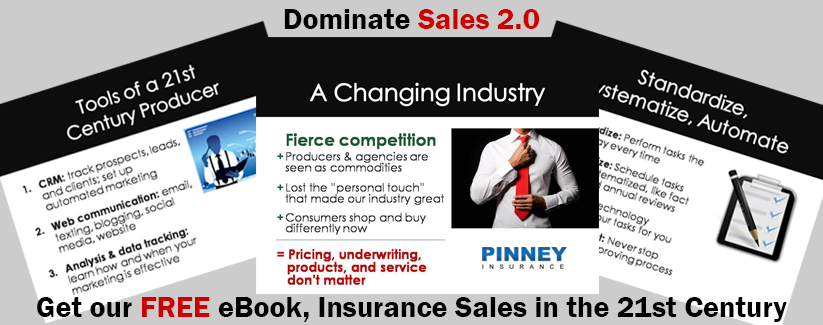
This month, we’re reading Originals: How Non-Conformists Move the World by Adam Grant. We picked this book because of a quote from the recent 2016 LIMRA Life Insurance Conference. At the conference, Kimberly Harris-Ferrante, VP and analyst at Gartner, said: “You have to ask yourselves, are we trying to be as good as other life insurance companies or are we trying to be as good as other companies?”
This begs the question—if we’re going to strive to be something better, why aim for parity with other companies? Shouldn’t we try and be better than other companies? We’ve talked a lot about our industry being ripe for disruption. If we’re truly headed for a face-off against giants like Amazon or Google, being as good as other companies might not be enough.
Why We Chose It
Originality itself starts with creativity: generating a concept that is both novel and useful.
Originals is about how to find and champion good ideas that go against the grain. With blurbs from everyone from JJ Abrams to Sheryl Sandberg (who wrote the foreword), it’s definitely got the business world’s disruptors behind it. Grant teaches at Wharton, so it’s his job to figure out what makes business successful.
Keep in mind, though, this isn’t necessarily a book about how to get a great business idea. It’s about how to spot a winning idea in the crowd, speak up on its behalf, and win people over to help you support that good idea even if most others are against it. It’s also about how to do that without risking everything in the process.
Sounds perfect for the insurance industry, doesn’t it?
Benchmarks for Success
In 2009, the author, Grant, declined to invest in a startup called Warby Parker. As you may know, the affordable eyewear company went on to huge success and a $1 billion valuation. Grant realized he made a mistake and decided to figure out why. Where had he gone wrong in evaluating the potential for Warby Parker’s success?
Originals are people who take the initiative to make their visions a reality.
Grant turned down the investment, in part, because the founders were still in school. Grant thought that if the founders truly believed in their idea, they’d drop out and put all their energy into the company. Secondly, the four founding members had different jobs and schedules, no company website, and had taken six months to pick a name for their company. The four fledgling businessmen all had day jobs lined up after graduation and planned to take them. They didn’t want the risk of going into uncharted territory—selling eyeglasses online—and staking their entire future on an unknown. So they were hedging their bets instead.
And Grant turned them down because of it, which turned out to be a big mistake.
What Your Browser Says About You
…acquiescence also robs us of the moral outrage to stand against injustice and the creative will to consider alternative ways that the world could work.
Grant talks about a study by economist Michael Housman. Housman studied data from 30,000 call-center employees. Surprisingly, the browser they used correlated with statistics about job performance. The employees who used Firefox or Chrome stayed in their jobs 15% longer, were 19% less likely to miss work, had higher customer satisfaction rates, and shorter average call times.
But what the heck does a browser have to do with that?
The answer might surprise you. Your browser choice says a lot about your mindset, according to Grant. Safari and Internet Explorer come pre-installed. If you’re using them, you’re settling for a default. In the study mentioned above, the call-center employees who used these browsers were less likely to deviate from their sales scripts or standard operating procedures.
If you’re using Firefox or Chrome, however, you’re closer to the mindset of the originals. You had to seek out and download those browsers because you believed they had more to offer than what came with your computer. Similarly, the call-center employees using Firefox or Chrome also looked for new ways of selling and solving their customers’ problems.
How to Be One of the Originals
Instead of aiming for unique accomplishments, the intense desire to succeed leads us to strive for guaranteed success.
The key point in Grant’s argument about the originals is this: they buck societal pressure to go with the default. It starts when we’re kids. Teachers praise the kids who follow the rules. The ones who make up their own rules get branded as troublemakers. The desire to achieve and be praised often stifles the creative impulse that could lead to original ideas that break through a technological or societal default. People as influential as George Washington and Steve Wozniak both had to be persuaded to accept their roles as disruptors, Grant reminds us.
Being an original entails taking steps to make your unconventional idea a reality. Are you willing to go that far? This involves a lot more than superficial statements of originality, like wearing a bow tie or bright red shoes (Grant's examples). It’s the ideas in your head and your heart that matter. What are you doing to make those a reality?
The people who do make their ideas a reality aren’t the most creative, most gifted, or the ones who take the biggest risks. They’re actually afraid of risk. They feel self-doubt. Sometimes they have to be forced to take center stage. Turns out, these are all the characteristics the Warby Parker founders had—and Grant realized that’s a big part of what made them successful.
Translating to the Life Insurance Industry
Being original doesn’t require being first. It just means being different and better.
Successful originals, Grant notes, take big risks in one arena and hedge that risk with conventional behavior in other arenas. That’s why so many innovators kept their day jobs for months or even years after becoming successful. They’re able to evaluate a slough of ideas and pick the ones that reflect the best mix of creativity (hey, that's new) and possibility (hey, I really think this could work). The more ideas they generate, the better they get at generating ideas. There’s also a creative warm-up process that needs to happen. Thirty-five ideas in a row might suck, but the thirty-sixth will be a game-changer. Successful originals keep going, keep doing, keep questioning, keep thinking…all while hedging their bets to avoid maximum risk.
What does that mean for us?
We have to keep doing what we’re doing. We need to keep selling life insurance as best as our current system allows.
But that's not all we have to do.
If we communicate the vision behind our ideas, the purpose guiding our products, people will flock to us.
We also need to branch out and see how other industries are solving the problems we haven’t solved yet. In this situation, our job experience is the enemy of our creativity. We get caught up in how things are usually done and we have trouble seeing how things should be done. In an NPR interview, Grant mentioned fashion designers. The most original designs usually come from people who travel and seek out new cultures and experiences. They let those new influences filter through their design aesthetic, creating something fresh.
For us, that means looking outside our industry. Who does a better job of making a complex product easy to understand and buy?
Let’s take the security we have in our jobs as agents and brokers, and use that to free up another part of our brains. We’re not risking our income and our security to re-invent the industry…yet. Given that, what’s your ideal solution for making life insurance easier to buy?
Get crazy with the ideas…until you find the one that you keep returning to. That’s the one you work to build support for.

